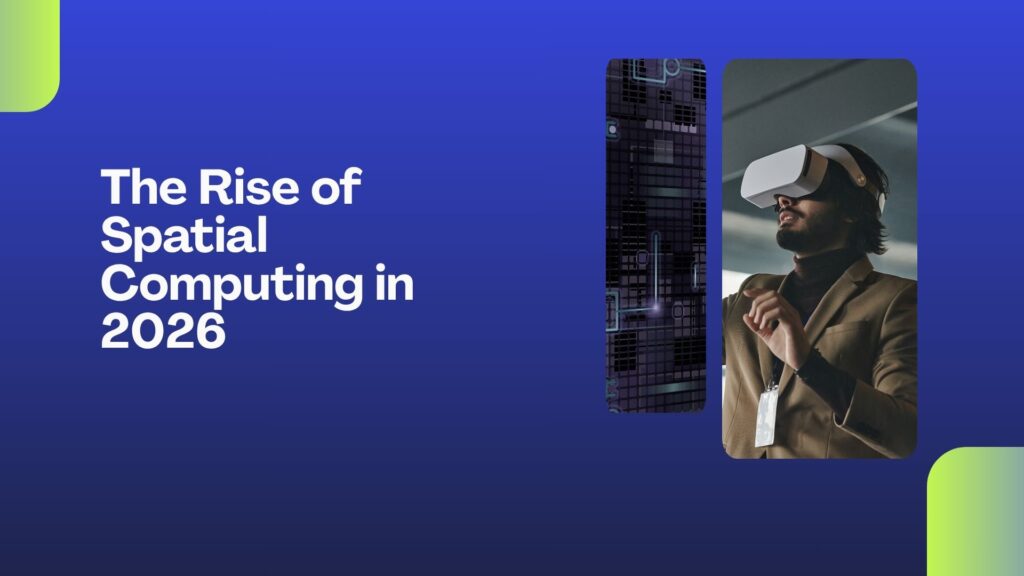In my opinion, technology is more than just innovation — it’s about how it connects, simplifies, and transforms our daily lives. I personally believe every new invention tells a story of progress and purpose, and that’s what I love exploring through my articles.
Overview
Technology in 2026 is changing fast, and one of the most exciting trends is spatial computing. This innovation goes beyond traditional screens and keyboards, allowing people to interact with digital content in a 3D,real-like experience . Whether it’s through AR glasses, VR headsets, or mixed-reality devices, spatial computing is changing the way we work, learn, and have fun.
In this article, we’ll provide a beginner’s guide to spatial computing in 2026, explaining what it is, why it matters, and how it is shaping the future of digital interaction.
What Is Spatial Computing?
Spatial computing is the use of digital technology to mix real life with digital content. Unlike standard computing that relies on flat screens, spatial computing places digital details right into your surroundings.
👉 Example: Imagine wearing smart glasses that show directions on the road while you walk, or a virtual screen floating in your room that replaces a physical monitor.
This idea is already used in areas like gaming, healthcare, education, and design.
Why Is Spatial Computing Important in 2026?
Spatial computing is not just a futuristic concept anymore—it’s becoming common in 2026. With tech giants launching new AR and VR devices, consumers now have more cheaper and easy-to-use choices.
Key reasons for its rise:
- real-like learning: Students can explore virtual classrooms.
- Work collaboration: Teams can meet in virtual spaces, even if they’re across the globe.
- Healthcare benefits: Doctors can use 3D models for surgeries and training.
- Entertainment: Games, movies, and virtual concerts are more engaging than ever.
Everyday Uses of Spatial Computing
1. Education & Training
Students can visit a virtual museum, explore planets in 3D, or attend engaging lessons. Businesses also use it for employee training with practice.
2. Healthcare
Surgeons use 3D overlays to plan complex surgeries, while patients receivestep-by-step therapy help through AR and VR devices.
3. Work & Productivity
Forget flat screens—spatial computing lets you create multiple floating computer screens. Collaboration tools make remote work feel more natural.
4. Retail & Shopping
Consumers can try furniture in their living rooms virtually or see clothes before buying them online.
5. Entertainment & Gaming
VR gaming, mixed-reality concerts, and 3D movies provide experiences that feel close to real life.
Devices Driving Spatial Computing in 2026
- AR Glasses: Lightweight and stylish, offering live digital details .
- VR Headsets: more comfortable, clearer, and wireless.
- Mixed-Reality Headsets: Combine real and digital worlds for best mix of both worlds.
- Holographic Displays: Screen-free,3D effects shown without screens .
👉 Example: Apple, Meta, and Microsoft are leading this space with next-gen devices designed for everyday consumers.
Challenges of Spatial Computing
While the future looks bright, there are still challenges:
- High costs of advanced devices.
- privacy risks because devices keep tracking.
- Need for better battery life and lighter devices.
- making content that looks simple and helpful.
The Future of Spatial Computing
By 2026 and beyond, spatial computing is likely to :
- Replace laptops and smartphones in some scenarios.
- push the next stage of the virtual world.
- change the way we work from home.
- open new businesses and jobs.
Beginner’s Tips to Explore Spatial Computing
- Start with low-cost AR glasses or mobile AR apps.
- Explore VR games or educational apps to get comfortable.
- Follow updates from tech companies working on AR/VR.
- Use devices that keep your privacy safe.
Closing Notes
Spatial computing is no longer just for tech enthusiasts—it’s becoming part of daily life. From learning and shopping to gaming and working, the rise of spatial computing in 2026 proves that our the way we use technology is moving into a new age .
For beginners, now is the perfect time to explore this field.The earlier you try it, the more you’ll benefit as spatial computing continues to grow.
Enjoyed this article? You might also find my previous post helpful: [https://techhorizonpro.com/how-lot-devices-are-shaping-smart-homes-in-2026/ ]
Written by Muhammad Zeeshan — a passionate tech enthusiast who loves exploring how innovation, AI, and digital tools are shaping the modern world.
I write with curiosity and clarity, aiming to make complex technology simple and useful for everyone.
If you enjoyed this post, check out my latest article for more insights on emerging tech trends and future innovations.




Pingback: Cloud Computing Trends 2026: Everything You Need to Know